

Equity Unbound » OneHE. Each of these resources includes a video or text demonstrating or describing the activity or exercise for community-building.
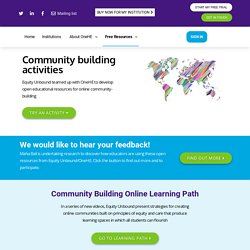
We also include descriptive text, slides you can reuse/adapt where relevant, and links to additional resources. We also show you how much time, what kind of resources you need, and different variations on the activity to help you adapt it for your purposes. Fostering Playfulness in Online Active Learning – Digital Learning & Inquiry (DLINQ) March 26 @ 12:00 pm - 1:15 pm EDT Friday, March 26, 2021 9:00-10:15 am Pacific / Noon- 1:15 pm Eastern Online via Zoom Finding yourself in a rut with your online activities?
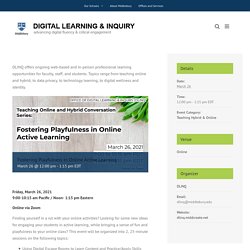
Looking for some new ideas for engaging your students in active learning, while bringing a sense of fun and playfulness to your online class? This event will be organized into 2, 25-minute sessions on the following topics: Using Digital Escape Rooms to Learn Content and Practice/Apply SkillsTrivia-Style Review Games Participants will choose one topic to attend during each 25-minute session. About the Teaching Online & Hybrid Conversation Series. GuidetoCourseDesignAug05. DLINQ Video Playlists – Digital Learning & Inquiry (DLINQ) Below are recommended video playlists for some of the common technologies and pedagogical approaches that support online teaching and learning.

For more information about specific technology tools, check out our Toolshed & Tutorials webpage.
6 Targets To Teach The Way The Brain Learns. ShareTwittPin Teach The Way The Brain Learns by Ramona Persaud When you’re standing in front of a classroom of students who’re not quite sure they even want to be in your class, much less pay attention to what’s being said, things like neuroscience, research studies, and teaching the way the brain learns are an abstraction.
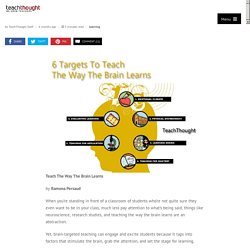
Yet, brain-targeted teaching can engage and excite students because it taps into factors that stimulate the brain, grab the attention, and set the stage for learning. Dr. Krug continues, “Learning only occurs when the student can connect new information to old information. Mettler also points out the importance of recognizing it as a non-linear process, “The components are all interrelated.” Brain Target 1: Establish the emotional climate for learning Neuroscience: The brain feels before it thinks. The SAMR Model and The 4 C's: Communicating Redefinition. For several years the SAMR model has provided us with a way to identify the level in which teachers are implementing lessons using technology.
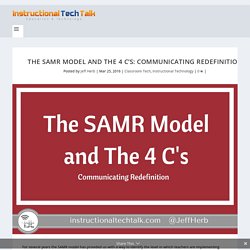
As it was originally developed, the model worked to motivate teachers to significantly change the way they were teaching – especially as technology was becoming more readily available in classrooms. At the brink of this mindset change, the SAMR Model was pivotal in starting those conversations and it ultimately provided a common language for us to challenge each other to think differently about the instruction we delivered and the way in which students learn. The SAMR Model (image created by @SylviaDuckworth) That said, we have moved beyond the SAMR Model as a sole means to effectively gauge technology-rich lesson effectiveness. What are the key skills that we must build into our lessons?
3 Adult Learning Theories Every E-Learning Designer Must Know. As an instructional designer, you want to create courses that make a difference to your audience’s lives.

You want to create courses that inspire them, that change mindsets and drive performance. In short, you want to create courses that are effective and hit the mark, every time. Now here’s the challenge. Your learners are adults with previous knowledge and fixed ideas about what works for them. Top 10 eLearning Content Development Companies For 2017. Scholarly EdTech Journals (Open Access) PaperIDEA 64. Critical Digital Pedagogy: a Definition - Hybrid Pedagogy. Your Personalized Learning Homepage. Limitless Education: Is Open Source an Option? by limitlessoss. NWeLearn: Limitless Education: Is Open Source an Option? Bell tower at Oregon State University.
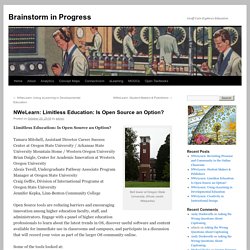
(Photo credit: Wikipedia) Limitless Education: Is Open Source an Option? Tamara Mitchell, Assistant Director Career Success Center at Oregon State University / Arkansas State University Mountain Home / Western Oregon UniversityBrian Daigle, Center for Academic Innovation at Western Oregon UniversityAlexis Terell, Undergraduate Pathway Associate Program Manager at Oregon State UniversityCraig Geffre, Division of International Programs at Oregon State UniversityJennifer Kepka, Linn-Benton Community College Open Source tools are reducing barriers and encouraging innovation among higher education faculty, staff, and administrators.
Engage with a panel of higher education professionals to learn about the latest trends in OS, discover useful software and content available for immediate use in classrooms and campuses, and participate in a discussion that will record your voice as part of the larger OS community online. NWeLearn: Creativity in Instructional Design. These are only my notes and impressions.
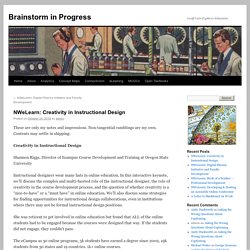
Non-tangential ramblings are my own. Contents may settle in shipping: Online Classes Get a Missing Piece: Teamwork. ‘Our Technology Is Our Ideology’: George Siemens on the Future of Digital Learning. What does it mean to be human in a digital age?

Some people researching education technology might not spend their days wondering how their work fits into this existential question—but George Siemens isn’t "some people. " “Maybe my mama hugged me extra when I was a baby.” That’s his explanation for how he thinks about the role of education in the 21st century. A researcher, theorist, educator, Siemens is the digital learning guy. He’s credited with co-teaching the first MOOC in 2008, introduced the theory of “connectivism”—the idea that knowledge is distributed across digital networks—and spearheaded research projects about the role of data and analytics in education. So You Want to Be an Instructional Designer? Good listener.

People person. Lifelong learner. Sound like you? No, we’re not trying to arrange a first date. These are some common traits of people with successful careers in a booming job market: instructional design. Colleges, K-12 schools and companies increasingly turn to instructional designers to help them improve the quality of teaching in in-person, online or blended-learning environments. SAMR Model - Technology Is Learning. Technology affordances. 6 Essential Tips for Planning an Effective Online Course.
Education Technology 101: From Assessments to Zombies. Blended & Personalized Learning Practices At Work. Google Goes Back to School with Updates to Classroom and Expeditions. It’s that time of the year—the time when companies start making back-to-school updates and announcements. First up: Google, in the form of updates to Classroom, Expeditions, and the overall Google for Education offerings, all announced on Google’s blog. Google Classroom: Email Summaries and Annotations Google Classroom, the company’s learning management system, is now getting a new feature. Teachers will now be able to share summaries of student work, classroom announcements and the like with parents (shown above), either by sending daily or weekly summaries via email or over the Google Classroom app, show below.
But that’s not all for Classroom’s mobile app. And one big update specifically geared towards teachers: now, teachers can organize the class stream by adding topics to posts so that teachers and/or students can filter the stream for specific topics. Bean Bags in the LMS – OFFICE OF DIGITAL LEARNING. Recently, I spoke with an English teacher at the University of Dayton who despaired over the cold, sterile environment the LMS creates for students and teachers alike. She asked why should she not be able to create a comfortable space for dialogue in her course? “I want my LMS to have bean bags in it, so that students can have a comfortable place to talk, to study, to engage.” The LMS doesn’t come with bean bags, unfortunately. And while Canvas, Middlebury’s new learning management solution, provides a level of ease in both design and function, it isn’t necessarily cozy.
Or beautiful. 7 Game Changer EdTech Tools to Personalize Your Classroom. By Stephanie Shaw. Caption, translate, subtitle and transcribe video. My pick of the best posts of June 2016. Sign Up.